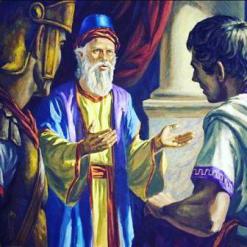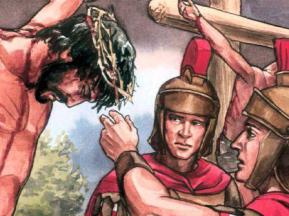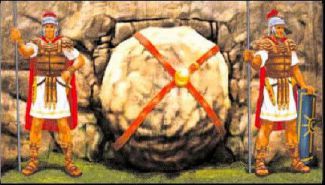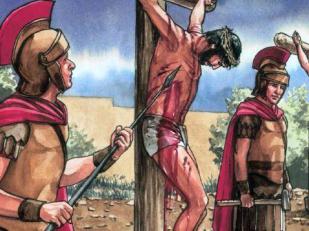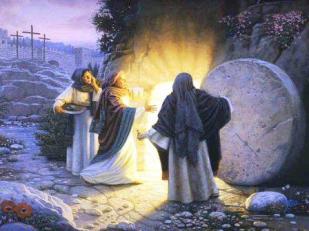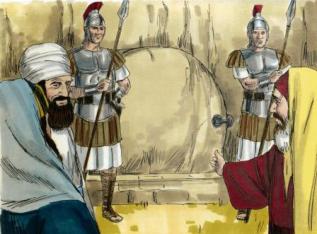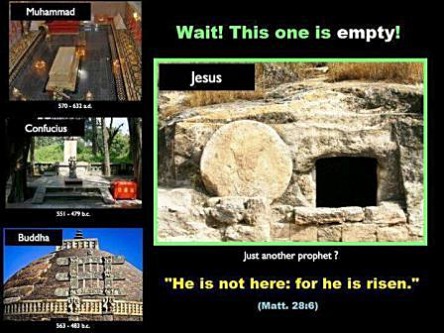Historical Proof that Jesus was really Dead
Professor E.H. Day relates: "It is St. Mark who lays stress upon Pilate's wonder at hearing that Christ was already dead, and upon his personal questioning of the centurion before he would give leave for the removal of the body from the Cross. The Roman soldiers were not unfamiliar with the evidences of death, or with the sight of death following upon crucifixion."[1]
Mark 15 (v. 43) Joseph of Arimathea, a prominent council member....coming and taking courage, went in to Pilate and asked for the body of Jesus. (v. 44) Pilate marveled that He was already dead; and summoning the centurion, he asked him if He had been dead for some time. (v. 45) So when he found out from the centurion, he granted the body to Joseph.
Pilate required certification of Christ's death. Of this Green remarks: "Four executioners came to examine him, before a friend, Joseph of Arimathea, was allowed to take away the body for burial....They knew a dead man when they saw one, and their commanding officer had heard the condemned man's death cry himself and certified the death to the governor, Pontius Pilate...."[2]
Mark 15 (v. 37) And Jesus cried out with a loud voice, and breathed His last. (v. 38) Then the veil of the temple was torn in two from top to bottom. (v. 39) So when the centurion, who stood opposite Him, saw that He cried out like this and breathed His last, he said, “Truly this Man was the Son of God!”
Professor Day observes that "the account in St. Matthew's Gospel of the guarding of the sepulcher is clear evidence that the Jews, for their part, believed that Jesus was dead." Day further points out that none "of those who were occupied with the taking down of the body, and its laying in the grave, [had] any suspicion that life remained."[1]
Matt 27 (v. 59) And when Joseph had taken the body, he wrapped it in a clean linen cloth, (v. 60) and laid it in his new tomb which he had hewn out of the rock; and he rolled a large stone against the door of the tomb, and departed. (v. 62) On the next day, which followed the Day of Preparation, the chief priests and Pharisees gathered together to Pilate, (v. 63) saying, “Sir, we remember, while He was still alive, how that deceiver said, ‘After three days I will rise’....(v. 65) Pilate said to them, “You have a guard; go your way, make it as secure as you know how.”
The Roman guard had been enabled to view the mighty angel who sang the song of triumph....At the wonderful scene which they were permitted to behold, they had fainted and become as dead men. When the heavenly train was hidden from their sight, they arose to their feet, and made their way to the gate of the garden as quickly as their tottering limbs would carry them. Staggering like blind or drunken men, their faces pale as the dead, they told those they met of the wonderful scenes they had witnessed. Messengers preceded them quickly to the chief priests and rulers, declaring, as best they could, the remarkable incidents that had taken place.[3]
Michael Green writes of Christ's death: "We are told on eyewitness authority that 'blood and water' came out of the pierced side of Jesus (John 19:34-35). The eyewitness clearly attached great importance to this. Had Jesus been alive when the spear pierced His side, strong spouts of blood would have emerged with every heart beat. Instead, the observer noticed semi-solid dark red clot seeping out, distinct and separate from the accompanying watery serum. This is evidence of massive clotting of the blood in the main arteries, and is exceptionally strong medical proof of death. It is all the more impressive because the evangelist could not possibly have realized its significance to a pathologist. The 'blood and water' from the spear-thrust is proof positive that Jesus was already dead."[2]
John 19 (v. 33) But when they came to Jesus and saw that He was already dead, they did not break His legs. (v.34) But one of the soldiers pierced His side with a spear, and immediately blood and water came out. (v. 35) And he who has seen has testified, and his testimony is true; and he knows that he is telling the truth, so that you may believe. (v. 36) For these things were done that the Scripture should be fulfilled, “Not one of His bones shall be broken.” (v. 37) And again another Scripture says, “They shall look on Him whom they pierced.”
Paul Althus, cited by Wolfhart Pannenberg, says: "In Jerusalem, the place of Jesus' execution and grave, it was proclaimed not long after his death that he had been raised. The situation demands that within the circle of the first community one had a reliable testimony for the fact that the grave had been found empty. The resurrection Kerygma [proclamation] could have not been maintained in Jerusalem for a single day....if the emptiness of the tomb had not been established as a fact for all concerned."[4]
Luke 24 (v. 1) Now on the first day of the week....they....came to the tomb bringing the spices which they had prepared. (v. 2) But they found the stone rolled away from the tomb. (v. 3) Then they went in and did not find the body of the Lord Jesus. (v. 4) And it happened, as they were greatly perplexed about this, that behold, two men stood by them in shining garments. (v. 5) ....they said to them, “Why do you seek the living among the dead? (v. 6) “He is not here, but is risen!
Matthew 28:11-15 records the attempt of the Jewish authorities to bribe the Roman guard to say the disciples stole Jesus body. The Dictionary of the Apostolic Church comments: "This fraudulent transaction proceeds upon the admission by the enemies of Christianity that the grave was empty—an admission which is enough to show that the evidence for the empty grave was too notorious to be denied."[5]
Matt 28 (v. 11) Now while they were going, behold, some of the guard came into the city and reported to the chief priests all the things that had happened. (v. 12) When they had assembled with the elders and taken counsel, they gave a large sum of money to the soldiers, (v. 13) saying, “Tell them, His disciples came at night and stole Him away while we slept.” (v. 14) “And if this comes to the governor’s ears, we will appease him and make you secure.” (v. 15) So they took the money and did as they were instructed; and this saying is commonly reported among the Jews until this day.
The guards were making their way first to Pilate, but the priests and rulers sent word for them to be brought into their presence. These hardened soldiers presented a strange appearance, as they bore testimony to the resurrection of Christ....They told the chief priests what they had seen at the sepulcher. They had not time to think or speak anything but the truth. But the rulers were displeased with the report. They knew the great publicity had been given to the trial of Christ, by holding it at the time of the Passover. They knew that the wonderful events which had taken place--the supernatural darkness, the mighty earthquake--could not be without effect, and they at once planned how they might deceive the people. The soldiers were bribed to report a falsehood.[6]
An Idea to Ponder in Our Thoughts....
Why did Jesus' sepulcher not become an object of veneration? J.N.D. Anderson comments that "it is also significant that no suggestion has come down to us that the tomb became a place of reverence or pilgrimage in the days of the early church. Even if those who were convinced christians might have been deflected from visiting the sepulcher by their assurance that their Maser had risen from the dead, what of all those who had heard His teaching, and even known the miracle of His healing touch, without joining the christian community? They too, it would seem, knew that His body was not there, and must have concluded that a visit to the tomb would be pointless."[7]
Luke 24 (v. 44) Then He said to them, “These are the words which I spoke to you while I was still with you, that all things must be fulfilled which were written in the Law of Moses and the Prophets and the Psalms concerning Me.” (v. 45) And He opened their understanding, that they might comprehend the Scriptures. (v. 46) Then He said to them, “Thus it is written, and thus it was necessary for the Christ to suffer and to rise from the dead the third day.... (v. 48) And you are witnesses of these things.”
Frank Morison in his book, "Who Moved the Stone?" makes an interesting observation: "Consider first the small but highly significant fact that not a trace exists in the Acts, or the Missionary Epistles or in any apocryphal document of indisputably early date, of anyone going to pay homage at the shrine of Jesus Christ. It is remarkable—this absolutely unbroken silence concerning the most sacred place in christian memory. Would no woman, to whom the Master's form was a hallowed recollection, ever wish to spend a few moments at that holy site?[8]
Would Peter and John and Andrew never feel the call of sanctuary that held all that was mortal of the Great Master? Would Saul himself, recalling his earlier arrogance and self-assurance, not have made one solitary journey and shed hot tears of repentance for his denial of the Name? If these people really knew that the Lord was buried there, it is very, very strange." To a critic of the resurrection, this extraordinary silence of antiquity concerning the later history of the grave of Jesus produces, I'm sure, a feeling of profound disquiet and unrest.[8]
Luke 24 (v. 50) And He led them out as far as Bethany, and He lifted up His hands and blessed them. (v. 51) Now it came to pass, while He blessed them, that He was parted from them and carried up into heaven.
As a lawyer I have made a prolonged study of the evidences for the events of the first Easter Day. To me the evidence is conclusive, and over and over again in the High Court I have secured the verdict on evidence not nearly so compelling. Inference follows on evidence, and a truthful witness is always artless and disdains effect. The Gospel evidence for the resurrection is of this class, and as a lawyer I accept it unreservedly as the testimony of truthful men to facts they were able to substantiate.[9]
As G.B. Hardy has said, “Here is the complete record:
Confucius tomb = occupied [ 551─479 B.C. ]
Buddha’s tomb = occupied [ 563─483 B.C. ]
Mohammed’s tomb = occupied [ 570─632 A.D. ]
Jesus tomb = Empty [ Matt 28:6 ]
The decision is now yours to make; the evidence speaks for itself. It says very clearly: Christ is risen indeed.[10]
Unlike the often-visited tombs of the founders of other world religions, the grave of Jesus Christ contains no well- preserved relics for today's tourists. While the followers of other religions often challenge christians to show them where their leader is enshrined, they are pointed only to an empty tomb. Yet the very fact that the body of Jesus Christ is not decaying in an earthen grave speaks of the power of Christianity. While the tombs of Mohammed, Abraham, and "The Buddha" bear witness to the final end of these "great men," the empty tomb of Christ is evidence of His power over death![11]
The bible states that an angel spoke to those seeking to visit His grave after His death with these words: "Why do you seek the living among the dead? He is not here, but is risen! (Luke 24:5-6)"....One enormous difference between christianity and every other religion in the world is an empty tomb! Only christians claim the resurrection of their founder. The apostle Paul stated that if there is no empty tomb or returning Lord, the inhabitants of Planet Earth are doomed to a life without meaning: "And if Christ is not risen, your faith is futile; you are still in your sins! Then also those who have fallen asleep in Christ have perished" (I Cor 15:17-18).[11]
See the risen Lord….Let this music video take you back there!! Ref. [12]
References:
1. Hermitage Day, (1906). On the Evidence for the Resurrection, p.46-48. Society for Promoting Christian Knowledge.
2. Michael Green, (1968). Man Alive, p.32-33. Inter-Varsity Press.
3. E.G. White, Selected Messages (book 1) “The Risen Saviour” p.303, par.1
4. Wolfhart Pannenburg, (1968). Jesus⎼God and Man, p.100. Westminster Press.
5. James Hastings, (1918). Dictionary of the Apostolic Church (vol.II) p.340. Edinburgh: T. & T. Clark.
6. E.G. White, Selected Messages (book 1) “The Risen Saviour” p.303, par.2
7. J.N.D. Anderson, (1970). Christianity: The Witness of History, p.97. Tyndale Press.
8. Frank Morison, (1967). Who Moved the Stone? p.137. London: Faber and Faber.
9. John Stott, (1971). Basic Christianity, p.47. Inter-Varsity Press.
10. Josh McDowell, (1979). Evidence that demands a verdict (vol.1), p.259-260. Here’s Life Publishers, Inc.
11. Mark Finley, (1995). Beyond Orion's Gates, p.290-291. Hart Research Center.
12. Natalie Grant. "Alive" with Lyrics. Online video. YouTube, 5 Apr 2012. https://www.youtube.com/watch?v=3AFpgzjRD44
Image #1: A view from the Right, (2015). Joseph of Arimathea requests Pilate release Jesus’ body to him. Retrieved from http://aviewfromtheright.com/2015/04/12/on-jesus-burial-9-reasons-the-gospels-are-credible/
Image #2: Free Bible Images, (n.d.). Jesus was dead on the cross. Retrieved from http://www.freebibleimages.org/illustrations/gnpi-099-jesus-burial/
Image #3: Photo credit: B5z.net, (n.d.). Roman seal on Jesus tomb. Retrieved from http://notmebutjesus.com/resurrection
Image #4: Free Bible Images, (n.d.). Jesus was pierced in the side with a spear. Retrieved from http://www.freebibleimages.org/illustrations/gnpi-099-jesus-burial/
Image #5: Encounter Jesus, (2006). The women goto the tomb. Retrieved from http://encounterjesus.blogspot.com/2006/11/meaning-of-redemption-and-salvation.html?m=0
Image #6: Five Fold Ministry Ireland, (2014). The tomb is sealed and guarded by roman soldiers. Retrieved from https://fivefoldministryireland.wordpress.com/2014/04/11/road-to-calvary-god-raises-jesus-from-the-dead/
Image #7: Bible Believers Fellowship, (2013). The graves of the greatest prophets. Retrieved from http://bbfohio.com/about-jesus/
